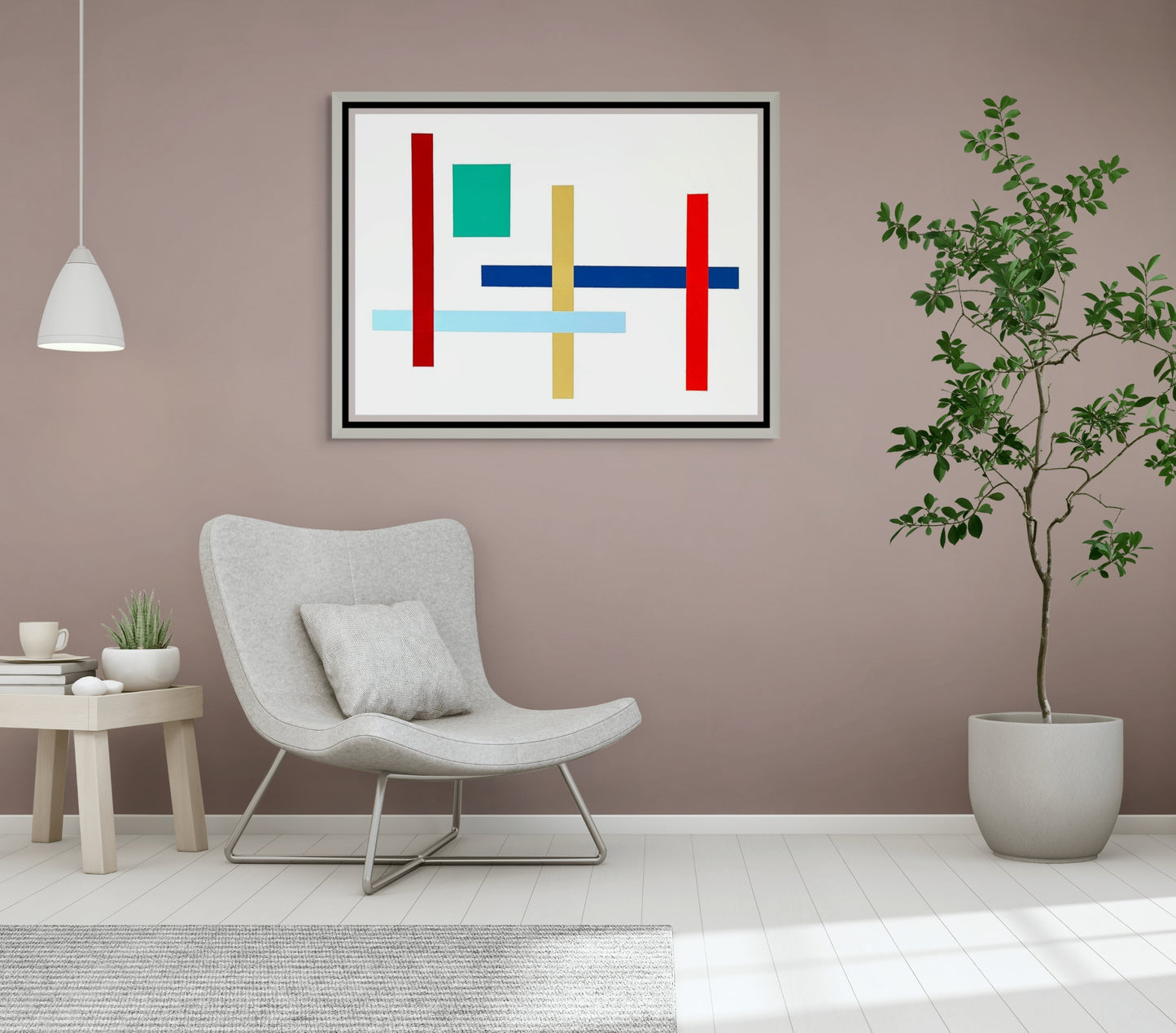The Fence, 30" x 40"
The Fence, 30" x 40"
See more paintings from the Floating Color Collection.

James Nowak’s The Fence, from the Floating Color Collection, presents a deliberate interplay between rigidity and openness, order and ambiguity. Through the use of horizontal and vertical bars intersecting across the canvas, Nowak evokes the metaphor of a fence—not as a literal boundary but as a symbolic structure mediating between freedom and constraint. Like his other works in the collection, this piece employs flat, vibrant colors and geometric clarity, yet its compositional language feels distinctly architectural and boundary-driven.
The composition is defined by intersecting vertical and horizontal bars. A dominant dark blue vertical intersects with red and ochre horizontal bars, forming the central “posts and rails” of the imagined fence. To the right, a lighter sky-blue vertical bar connects with a lower red bar, reinforcing the sense of partitioning.
The teal-green square in the lower left provides a counterpoint to the linear system, introducing a solid, enclosed form into a field of crossings. Its placement feels almost “trapped” behind the fence structure, visually enacting the metaphor of boundary.
The spacing of bars leaves expanses of white negative space, ensuring the composition does not collapse into density. Instead, the “fence” feels porous—both barrier and passage.
Nowak’s color palette in The Fence is both disciplined and expressive.
- Red is bold, commanding attention and asserting authority, functioning as a horizontal barrier across the composition.
- Blue appears in two registers: the deep navy vertical lends gravity, while the sky-blue vertical softens the structural system, introducing lightness and permeability.
- Ochre provides warmth and stability, suggesting grounding or earth-like solidity.
- The teal-green square is vibrant and self-contained, providing an emotional resonance of vitality and renewal.
Together, these colors animate the rigid linearity of the fence with emotional complexity, making it feel less like a wall of exclusion and more like a permeable system of relationships.
As in the other works of the Floating Color Collection, the white background functions as an atmospheric space rather than emptiness. The bars and square hover in suspension, untethered from perspective or material reality.
Yet unlike Sunny Day or Blue Line, where floating conveys playful buoyancy, The Fence introduces a sense of stability and groundedness. The verticals and horizontals feel anchored, implying order and confinement. The floating effect is still present but countered by the weight of the structural motif.
The title The Fence frames the composition as a meditation on boundaries. Fences are paradoxical: they divide and protect, restrict and define. In Nowak’s painting, the bars suggest both separation and rhythm, order and interruption. The teal-green square may symbolize individuality, enclosed within but also contrasting the larger structural system.
Emotionally, the work oscillates between tension and harmony. The rigid geometry evokes discipline, yet the bright, lively colors soften the severity, suggesting that even within boundaries there can be play, life, and openness.
The Fence resonates with the geometric purity of Piet Mondrian and De Stijl, yet Nowak diverges by imbuing his structures with metaphor. Mondrian’s grids sought universal harmony, while Nowak’s bars seem to ask questions about division and coexistence. The work also recalls the architectural spirit of Constructivism, where art was envisioned as structure, yet here the “fence” is stripped of utilitarian function and exists purely as visual metaphor.
James Nowak’s The Fence exemplifies how abstraction can move beyond formal play into conceptual reflection. By arranging bold bars and a solitary square within a floating field, Nowak conjures both the physicality and symbolism of boundaries. The painting is not merely an arrangement of color and geometry but a meditation on how separation and connection coexist. In balancing rigidity with vibrancy, The Fence transforms the language of abstraction into a poetic reflection on structure, freedom, and the spaces between.

